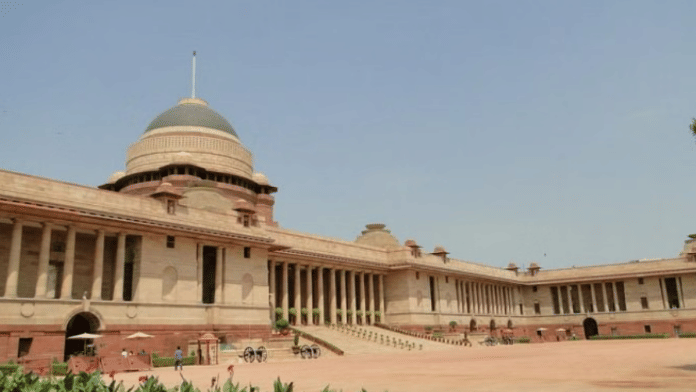New Delhi: Rashtrapati Bhavan’s Durbar Hall and Ashok Hall have been renamed Ganatantra Mandap and Ashok Mandap respectively by President Droupadi Murmu, in an endeavour to make the “ambience” of the President’s official address “reflective of the Indian cultural values and ethos”.
Ganatantra Mandap, previously Durbar Hall, serves as a venue for important government ceremonies and celebrations, including civil and defence investiture ceremonies. It also hosts the swearing-in of incoming central governments, induction of new ministers, and the installation of the Chief Justices of India.
“‘Durbar Hall’ is the venue of important ceremonies and celebrations such as the presentation of National Awards. The term ‘Durbar’ refers to courts and assemblies of Indian rulers and the British. It lost relevance after India became a Republic, that is, ‘Ganatantra’. The concept of ‘Ganatantra’ is deeply rooted in Indian society since ancient times, making ‘Ganatantra Mandap’ an apt name for the venue,” a government release read.
Ashok Mandap, formerly Ashok Hall, was originally designed as a ballroom and has since evolved into a ceremonial venue of international stature. It serves as the stage for the presentation of credentials by heads of missions from foreign countries, a formal rendezvous for diplomatic introductions preceding state banquets hosted by the President.
“‘Ashoka’ refers to Emperor Ashok, a symbol of unity and peaceful co-existence. The National Emblem of the Republic of India is the lion capital of Ashok from Sarnath. The word also refers to the Ashok tree which has deep significance in Indian religious traditions as well as arts and culture. Renaming ‘Ashok Hall’ as ‘Ashok Mandap’ brings uniformity in language and removes the traces of anglicisation while upholding the key values associated with the word ‘Ashok’,” the release stated.
Artwork in these halls
Formerly known as the Throne Room, the Durbar Hall witnessed C. Rajagopalachari taking oath as India’s Governor-General in 1948 and is “indisputably the most regal room of the presidential palace”. It has also hosted the swearing-in ceremony of Independent India’s inaugural government, the official website notes.
Presently, the Durbar Hall serves as the venue for civil and defence investiture ceremonies, and hosts swearing-in ceremonies. In 1977, it was used to pay tribute to India’s fifth President, Fakhruddin Ali Ahmed, after his demise.
In the Durbar Hall corridor, busts of former Indian Presidents sculpted by renowned artists are on display. The marble walls feature life-sized paintings of Mahatma Gandhi by Venkatesh D. C., Rajagopalachari by Biren De, Jawaharlal Nehru by Gerasimov, and Dr Rajendra Prasad by J.A. Lalkaka.
The Ashok Hall at Rashtrapati Bhavan, originally the State Ballroom, on the other hand, now serves as a venue for diplomatic presentations and formal introductions before state banquets hosted by the President. It has paintings depicting Fath Ali Shah, the second of seven Qajar rulers of Persia, hunting a tiger in the presence of his 22 sons. Initially, only one part of the hall had the design. Later, Italian artist Tomasso Colonnello extended the central theme of a jungle to the entire hall.
Other artworks include paintings of Persian poet Nizami and an unknown Persian lady, positioned respectively behind the southern and northern arches of Ashok Hall.
(Edited by Tikli Basu)
Also read: President Murmu receives first copies of four books on her speeches, Rashtrapati Bhavan’s heritage






